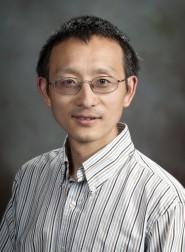 |
Dr. Jianhua Xing (Assistant Professor)
Department of Biological Sciences,
Virginia Tech, Blacksburg, VA 24060, USA
|
Abstract: Conventionally chemical physics is a field that mainly investigates physical/chemical phenomena at atomic and molecular levels. Noticing the analogy between molecular (especially macromolecular) dynamics and cellular dynamics, in the past few years my lab has focused on introducing and generalizing the techniques and concepts of chemical physics into cell biology studies. Specifically in this talk I will mainly discuss our recent theoretical study on cell reprogramming inspired by protein physics.
Recent breakthroughs of cell phenotype reprogramming hold a great promise that quantitative understanding of phenotypic transition dynamics would be a key step towards future development of cell biology. Theoretical descriptions of cell differentiation can be dated back to Waddington’s phenomenological picture of epigenetic landscape. Yet, despite its popularity the question of how to map the epigenetic landscape into predictive models remains largely unanswered. Here we develop a novel “epigenetic state network” (ESN) approach capturing global architecture of cell phenotypes that helps turning the conceptual epigenetic landscape into a more quantitative fashion. As a testing case, we apply the approach to describe the fibroblast (FB) reprogramming dynamics. The resulting ESNs predict that an FB can be reprogrammed to a cardiomyocyte (CM) through three major pathways. One is to be induced to pluripotent stem cell (iPSC), through a major pathway crossing pre-iPSC state or a less probable pathway avoiding trapped in the pre-iPSC state, then to follow the normal pathway of differentiation to cardiomyocyte; the other two pathways are transdifferentiation (TD) from FB to CM either indirectly going through cardiac progenitor (CP), or directly without going through CP. Numerous experimental observations support the predicted states and pathways. Our approach may apply for quantitative studies of various cell phenotypic reprogramming processes and long time dynamics of large scale complex networks in general.
If time allowed, I will also discuss our recent efforts on using the Zwanzig-Mori projection approach to reconstruct dynamic models of a complex system from data in reduced dimensions.
Date&Time: October 19, 2012 (Friday), 10:30–11:30a.m.
Location: 606 Conference Room


